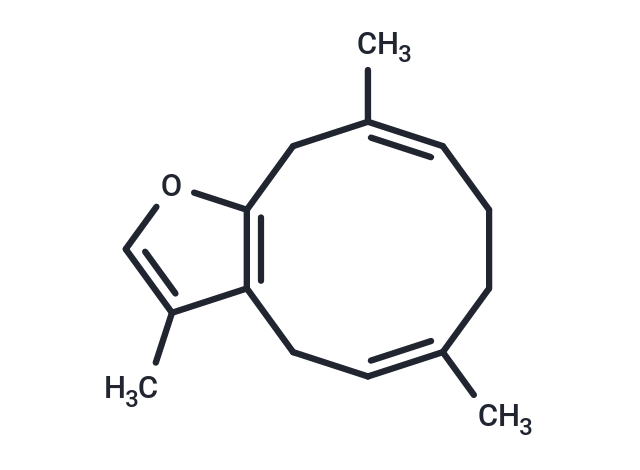Shopping Cart
Remove All Your shopping cart is currently empty
Your shopping cart is currently empty
Furanodiene is a type of terpenoid natural product that can inhibit the function of efflux transporter Pgp and reduce the level of Pgp protein. It exerts anti-cancer effects through anti-angiogenesis, inducing ROS production, DNA strand breakage and cell apoptosis.

| Pack Size | Price | USA Warehouse | Global Warehouse | Quantity |
|---|---|---|---|---|
| 1 mg | $35 | - | In Stock | |
| 5 mg | $81 | - | In Stock | |
| 10 mg | $129 | - | In Stock | |
| 25 mg | $219 | - | In Stock | |
| 50 mg | $326 | - | In Stock | |
| 100 mg | $485 | - | In Stock | |
| 200 mg | $693 | - | In Stock |
| Description | Furanodiene is a type of terpenoid natural product that can inhibit the function of efflux transporter Pgp and reduce the level of Pgp protein. It exerts anti-cancer effects through anti-angiogenesis, inducing ROS production, DNA strand breakage and cell apoptosis. |
| In vitro | The in vitro effects of Furanodiene were examined on two human breast cancer cell lines, MCF-7 and MDA-MB-231 cells. Assays of proliferation, LDH release, mitochondrial membrane potential (ΔΨm), cell cycle distribution, apoptosis and relevant signaling pathways were performed. The in vivo effect was determined with MCF7 tumor xenograft model in nude mice. Furanodiene significantly inhibited the proliferation and increased the LDH release in both cell lines in a dose-dependent manner. ΔΨm depolarization, chromatin condensation, and DNA fragmentation were also observed after Furanodiene treatment. Furanodiene dose-dependently induced cell cycle arrest at the G0/G1 phase. The protein expressions of p-cyclin D1, total cyclin D1, p-CDK2, total CDK2, p-Rb, total Rb, Bcl-xL, and Akt were significantly inhibited by Furanodiene, whereas the protein expressions of Bad and Bax, and the proteolytic cleavage of caspase-9, caspase-7, and poly-ADP-ribose polymerase (PARP) were dramatically increased. Furthermore, the z-VAD-fmk markedly reversed the Furanodiene-induced cell cytotoxicity, the proteolytic cleavage of caspase-9, and DNA fragmentation but did not affect the proteolytic cleavage of PARP, whereas the Akt inhibitor VIII increased the Furanodiene-induced cytotoxicity and PARP cleavage. In addition, Furanodiene dose-dependently suppressed the tumor growth in vivo, achieving 32% and 54% inhibition rates after intraperitoneal injection of 15 mg/kg and 30 mg/kg, respectively[1] |
| Molecular Weight | 216.32 |
| Formula | C15H20O |
| Cas No. | 19912-61-9 |
| Smiles | CC=1C2=C(OC1)C\C(\C)=C/CC/C(/C)=C\C2 |
| Relative Density. | no data available |
| Color | White |
| Appearance | Solid |
| Storage | keep away from direct sunlight,keep away from moisture,store at low temperature | Powder: -20°C for 3 years | In solvent: -80°C for 1 year | Shipping with blue ice/Shipping at ambient temperature. | ||||||||||||||||||||
| Solubility Information | DMSO: 10 mM, Sonication is recommended. | ||||||||||||||||||||
| In Vivo Formulation | 10% DMSO+40% PEG300+5% Tween 80+45% Saline: 2 mg/mL (9.25 mM), Sonication is recommended. Please add the solvents sequentially, clarifying the solution as much as possible before adding the next one. Dissolve by heating and/or sonication if necessary. Working solution is recommended to be prepared and used immediately. The formulation provided above is for reference purposes only. In vivo formulations may vary and should be modified based on specific experimental conditions. | ||||||||||||||||||||
Solution Preparation Table | |||||||||||||||||||||
DMSO
| |||||||||||||||||||||
| Size | Quantity | Unit Price | Amount | Operation |
|---|

Copyright © 2015-2025 TargetMol Chemicals Inc. All Rights Reserved.